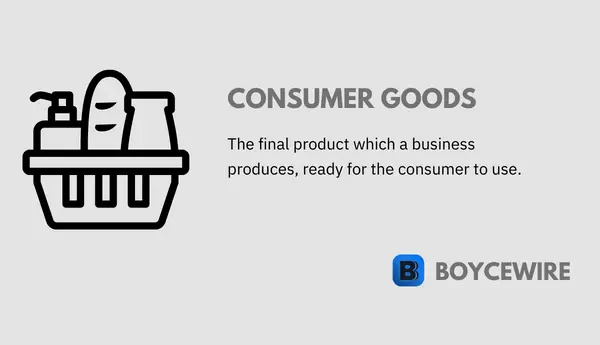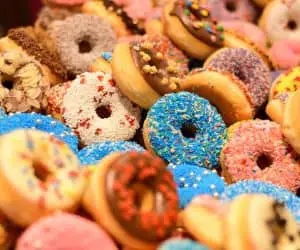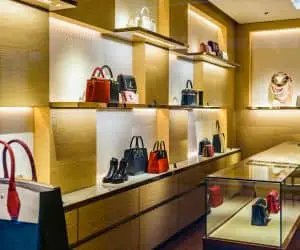Consumer Goods: Definition, Types & Examples

What are Consumer Goods?
Consumer goods, also known as final goods, are the end products that businesses produce and sell to consumers. Examples of consumer goods include microwaves, fridges, t-shirts, and washing machines – these are all products that consumers purchase for their own use.
Consumer goods are different from intermediate goods, which are used in the production of final consumer goods. Raw materials like copper, coal, and iron are not consumer goods because they are used to manufacture final consumer goods. For example, copper can be used to create trays, bowls, and other containers, which are considered consumer products. These trays, bowls, and containers are intermediate goods that are used to create final consumer goods.
Key Points
- Consumer goods, also know as final goods, are those that are consumed by the customer and are not used to make other goods.
- They include durable goods, such as appliances and cars, nondurable goods, such as food and toiletries, and services, such as haircuts and medical treatment.
- There are 4 main types of consumer goods. They are convenience goods, speciality goods, shopping goods, and unsought goods.
Types of Consumer Goods
1. Convenience Goods
The term “convenient” means “involving little trouble or effort“. Therefore, convenience products are products that require little effort or inconvenience to purchase. They are easily accessible and frequently purchased.
Examples of convenience products include food, drinks, laundry detergent, toilet paper, deodorant, and toothpaste. These goods are readily available at local supermarkets, and consumers often purchase them on a daily, weekly, or monthly basis. This is why they are referred to as convenience products.
Example of Convenience Goods

Products that are regularly purchased with little effort required are known as convenience products. For instance, if you have a favorite type of cereal that you buy every week, you would go directly to the cereal aisle and pick it up without much thought. This is convenient because you don’t spend a lot of time deciding whether you prefer Coco-Pops or Cheerios.
Characteristics of Convenience Goods
The main characteristics of Convenience Goods include:
- Frequently purchased
- Easily available
- Relatively low price
- Non-durable
2. Shopping Goods
Shopping goods differ from convenience products in that they are purchased less frequently and are not as easily accessible. Consumers take more time to make a decision and put in more deliberate effort before buying them.
Examples of shopping goods include furniture, clothing, video games, mobile phones, fridges, and other household appliances. These products are not as easily available as convenience goods like fruits, vegetables, and cereals, nor are they purchased as frequently. Therefore, consumers tend to take more time to decide on what to buy.
Example of Shopping Goods

Shopping products require consumers to invest more time in the decision-making process. This is because the opportunity cost of making a wrong decision is higher compared to trying a new loaf of bread. For example, when choosing a new mobile phone, a consumer may end up paying $500 for a phone they end up disliking. Therefore, the incentive to make the correct decision is greater, and consumers take more time to evaluate their options.
Characteristics of Shopping Goods
The main characteristics of Shopping Products include:
- Infrequently purchased
- Not so easily available
- Compared to other similar goods
- Greater opportunity cost
- Durable
3. Speciality Goods
Specialty products are goods that consumers do not take long to decide to purchase. They have unique characteristics, such as being rare or having an original design, making them largely incomparable to other products. Examples of specialty products include sports cars, rare paintings, high-end laptops, rare ornaments, and designer clothing.
Specialty products are naturally unique, but they can also rely on brand recognition. For example, Ferrari is known for producing high-quality sports cars, and Picasso is renowned for his masterpieces. The products they produce are considered specialty items because they represent a high level of quality and exclusivity.
Example of Speciality Goods

Specialty products share some similarities with shopping products, such as being infrequently purchased, durable, and having a high opportunity cost. However, what distinguishes specialty products is that consumers do not take as long to decide on them. The brand image of a Ferrari or a Picasso sells itself, so if the consumer has the financial means and a preference for the brand, they are more likely to make a purchase with ease.
Characteristics of Speciality Goods
The main characteristics of Speciality Products include:
- Infrequently purchased
- Rare
- Expensive
- Durable
4. Unsought Goods
Unsought products can range from new innovations to old goods that consumers are not aware of or would not think to buy. These products often do not offer any immediate benefit to the consumer. For instance, insurance is an unsought good that many consumers purchase to reduce their risk, but few people enjoy buying insurance.
To make unsought products more appealing, they often require significant marketing efforts and investment. This is because consumers may not be aware of the benefits that the product provides.
For example, life insurance is an unsought good that many people may not want to consider purchasing because it requires thinking about one’s own death. However, aggressive marketing campaigns have increased consumer awareness of the benefits, such as pre-paid funeral care and legal fees, and have turned life insurance into a sought-after product.
Characteristics of Unsought Goods
The main characteristics of Unsought Products include:
- Undesirable
- Consumers lack of knowledge on the product
- Usually purchased to prevent a negative outcome
- Infrequently purchased
Consumer Goods Examples
Consumer goods are products that are intended for final consumption by the consumer. Unlike capital or intermediary goods, they represent the final product and are not used to manufacture other products.
One of the primary characteristics of consumer goods is their availability for purchase by consumers. If a good is available for purchase and is not used to make another product, it is considered a consumer good.
1. Doughnuts
Doughnuts are an example of convenience consumer good due to their high frequency of purchase, easy accessibility from local stores, and relatively low price. Being a non-durable good further reinforces their convenience, as they are meant for immediate consumption.
Moreover, since the potential cost of an incorrect decision is low, consumers typically do not need to exert much time or effort in deciding whether or not to purchase doughnuts, making them an ideal example of a convenient product.

2. Ferrari
A Ferrari is a speciality consumer good due to its unique and expensive nature. It is durable and infrequently purchased. However, it is not a shopping good as it is incomparable to other products because of its unique features. Speciality goods cannot be compared like shopping goods.
3. Gucci Handbag
A Gucci handbag is an example of a speciality consumer good. Like the Ferrari, it is unique and incomparable to other products due to its distinctive design. If a consumer likes the design, they won’t be able to find it elsewhere. In contrast, products such as bread or basic laptops are largely interchangeable.

4. Laptop
Laptops can be classified as either speciality products or shopping products. High-end laptops such as Apple MacBook Pros or Google Pixelbooks are speciality consumer goods due to their unique design without a comparable product.
Apple’s software also has unique features, further making it a specialist product. On the other hand, low-end laptops are shopping consumer products as there is a wide variety with little differentiation between them. It requires some level of research to determine which is the best option.

5. Life-Insurance
Life insurance is classified as an unsought consumer good, as it is not something that most consumers actively seek out to purchase. Rather, it relies heavily on advertising and sales techniques to attract consumers.
This is because consumers typically do not purchase life insurance out of desire or want, but rather to mitigate the risk of adverse events in the future. Unlike convenience or specialty goods, life insurance does not offer an immediate benefit to the consumer, but rather provides a benefit at a later date.
6. Pre-paid Funeral
Pre-paid funerals are another example of an unsought consumer good. They are not purchased out of pure desire or willingness, but rather to avoid potential adverse effects in the future.
For instance, a father may fear that his children will not be able to afford his funeral expenses, so he may choose to pay for the service in advance to relieve the burden on his children. There is no immediate benefit to the father, which is why it is an unsought good.
Durable and Non-durable Consumer Goods
Consumer goods can be categorized into durable and non-durable goods. Durable goods can be used over a long period of time and are not completely consumed after one use.
Examples of durable goods are fridges, microwaves, and motor vehicles. Non-durable goods, on the other hand, are consumed completely after one use and no longer exist. Examples of non-durable goods include food, drink, and cigarettes. Once consumed, non-durable goods cannot be used again, while durable goods can be used over and over again.
Here are some key points about these two types of goods:
Durable goods
- Durable goods are products that are expected to last for a long time, usually more than three years.
- Examples of durable goods include appliances, furniture, electronics, and automobiles.
- Consumers usually spend more money on durable goods, and they tend to make less frequent purchases.
- Durable goods are usually more expensive than non-durable goods, and they require more research and consideration before purchase.
- The demand for durable goods is often influenced by factors such as interest rates, consumer confidence, and innovation.
Non-durable goods
- Non-durable goods are products that are expected to be consumed or used up quickly, usually within less than three years.
- Examples of non-durable goods include food, beverages, toiletries, and cleaning supplies.
- Consumers usually spend less money on non-durable goods, and they tend to make more frequent purchases.
- Non-durable goods are usually less expensive than durable goods, and they are often bought on impulse or for immediate needs.
- The demand for non-durable goods is often influenced by factors such as population growth, inflation, and seasonal trends.
Overall, durable goods and non-durable goods play an important role in the economy and consumer behavior. Understanding the differences between these two categories can help individuals and businesses make informed purchasing decisions and plan for future growth.
FAQs
Consumer goods are products that are purchased by individuals or households for their personal use or consumption.
There are four main types of consumer goods:
– Convenience
– Shopping
– Speciality
– Unsought
Consumer goods cover convenience products such as doughnuts and milk, shopping products such as laptops, speciality products such as Ferrari’s and Gucci handbags, and unsought products such as pre-paid funeral funerals and life-insurance.
Consumer goods are products that are used by individuals or households for personal use or consumption, while capital goods are products that are used to produce other goods and services.
Convenience goods are products that are purchased frequently and with minimal effort, such as snacks, beverages, and toiletries.
About Paul
Paul Boyce is an economics editor with over 10 years experience in the industry. Currently working as a consultant within the financial services sector, Paul is the CEO and chief editor of BoyceWire. He has written publications for FEE, the Mises Institute, and many others.

Further Reading
 Coase Theorem: Definition & Example - Coase theorem is the idea that under certain conditions, the issuing of property rights can solve negative externalities.
Coase Theorem: Definition & Example - Coase theorem is the idea that under certain conditions, the issuing of property rights can solve negative externalities.  Economic Profit Definition - Economic profit is a firms total revenue minus its total costs, including implicit and explicit costs.
Economic Profit Definition - Economic profit is a firms total revenue minus its total costs, including implicit and explicit costs.  Prospect Theory: Definition & Examples - Prospect theory is based upon the premise that individuals value losses and gains differently.
Prospect Theory: Definition & Examples - Prospect theory is based upon the premise that individuals value losses and gains differently. 